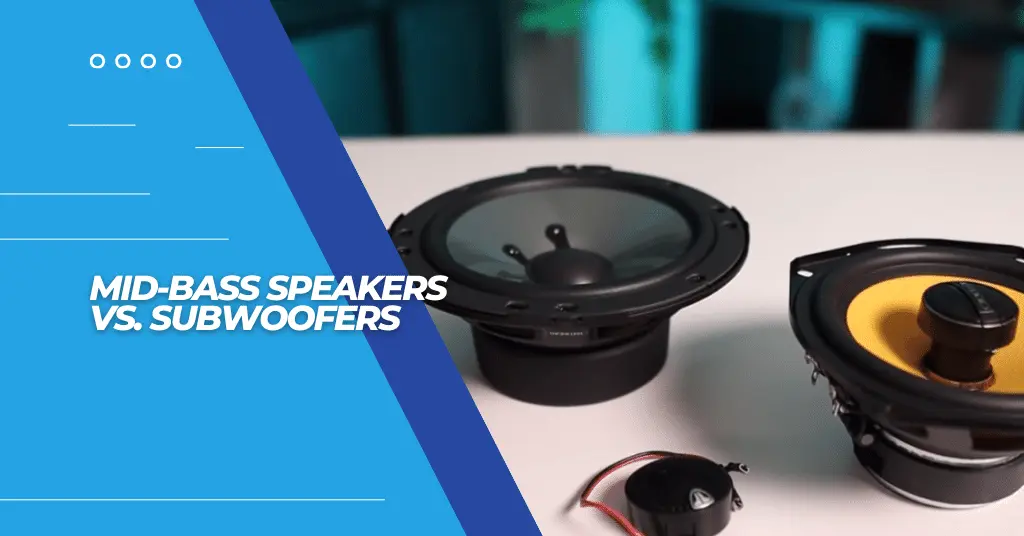Mid Bass Speakers vs Subwoofer

Audiophiles always look for bass whenever it comes to enjoying music. However, if you are one too and looking to get the missing bass in your home or car audio system but don’t know which audio device you should get, you can read this article to the end!
On a lighter note, mostly mid-bass speakers can handle frequencies from 200Hz to 500Hz, emphasizing the richness of vocals and instruments. While subwoofers take the range to the lower end, typically from 20Hz to 200Hz, delivering deep bass that underscores rhythms and sound effects.
What Are Mid Bass Speakers?

As I mentioned at the start of the article, mid-bass speakers can reproduce mid-frequency sounds ranging from 200Hz to 500Hz.
In this frequency band, you may hear the keynotes of many musical instruments, such as guitars and pianos, and even vocals sometimes.
Serving as a bridge between the higher midrange tones and deeper bass, mid-bass speakers add warmth and depth to the audio output, enhancing the overall balance in a sound system.
Key Features of Mid Bass Speakers:
Here are some of the critical points that you will find in these speakers:
- Sound Clarity: The frequency range that I discussed is a really important factor because it encapsulates a majority of the ‘human voice’ frequencies, as well as the key tonal elements of many musical instruments. A high-quality midrange speaker can deliver clear, detailed audio by accurately reproducing these frequencies.
- Size and Design: You will find midrange speakers between 5 and 8 inches in size. A well-designed mid-range speaker will have a cone and magnet structure that allows it to handle powerful signals without distortion. Furthermore, the size of the midbass speaker affects its ability to move air and generate sound waves.
- Cone Materials: Mostly, midrange speakers rely heavily on the cone material for their sound quality. Polypropylene is popular because it is lightweight and robust, producing clear, distortion-free sound among these speakers. On the other hand, paper cones provide a warm tone and are appreciated by audiophiles for their natural sound reproduction. Kevlar cones, known for their strength and lightweight properties, offer a precise, punchy sound, making them ideal for genres like rock and pop.
When Should You Use Mid-Range Speakers?
You can use midrange speakers in almost every scenario where sound clarity is more important than the bass (It gives midrange frequency range). I suggest using these speakers for the following:
- Music Systems: As mentioned above, mid-range speakers are essential for accurately reproducing sounds of vocals and instruments like guitars and pianos, thereby enriching the overall music-listening experience.
- Home Theaters: Midrange speakers enhance sound clarity, ensuring that dialogues in movies and shows are crisp and easily understandable.
- Live Events: At concerts or public addresses, mid-range speakers provide a balanced sound and prevent the voice from being drowned out by bass or treble frequencies.
- Car Audio: They ensure a well-rounded in-car audio experience by capturing the essence of songs and making spoken words clear.
- Recording Studios: Mid-range speakers are crucial for accurate sound monitoring, aiding in the mixing and mastering of tracks.
What Is a Subwoofer?

A subwoofer is a special type of speaker engineered to produce very low-frequency sounds, generally falling between 20Hz and 200Hz, which are the deep bass elements in music, movies, and other audio content.
Unlike midrange speakers, these frequencies give the audio a sense of depth and richness that ordinary speakers struggle to replicate.
Subwoofers come in two main types: passive subwoofers, which need an external amplifier to function, and active subwoofers, which have an amplifier built in.
Key Features of Subwoofers:
Here are some of the critical features of a subwoofer:
- Sound Depth: Unlike midrange bass speakers, subs reproduce more low-pitched bass frequencies to add depth to the sound. They generate long sound waves, allowing them to move around objects and fill a room effectively. This creates a multi-dimensional soundscape that enhances the complexity and richness of music, and the realism of movie soundtracks.
- Size and Design: You will find subwoofers in a variety of sizes, each offering different bass output levels. For example, Compact 6-inch models are perfect for small spaces, delivering sufficient bass without overwhelming the room. On the other hand, larger models, such as the massive 18-inch or even bigger units, produce profound and robust bass, thus enhancing the depth and richness of the sound.
When Should You Use a Subwoofer?
You can use a subwoofer in every scenario. However, the below are more suitable options:
- Enhancing Home Theater Systems: Subwoofers can really amplify your cinematic experiences, adding depth to explosions, rumbles, and other low-frequency effects.
- Listening to Music: If you are more into genres like hip-hop, electronic, and orchestral, where bass lines and low-frequency instruments are prominent, you should give the subwoofer a chance.
- Car Audio System: People mostly love adding subwoofers to their car audio system. Especially those audiophiles who want to compete in the bass competition should aim for subwoofers.
Mid Bass Speakers vs Subwoofers:
Until now, you might have known the difference between midrange speakers and subwoofers. However, let’s compare them side by side now:
| Features | Midbass Speakers | Subwoofers |
|---|---|---|
| Frequency Range | 200Hz to 500Hz | 20Hz to 200Hz |
| Primary Role | Reproduce mid-frequency sounds | Deliver deep bass sounds |
| Size & Design | Often more compact | Typically larger with specialized enclosures |
| Usage | Enhance vocals & instruments clarity | Enhance depth in music & cinematic effects |
| Typical Placement | Integrated with main speakers | Separate placement for optimal bass |
| Integration | Blend with highs and lows | Works with crossovers to handle lowest frequencies |
| My Sound Experience | Warmth, detail, and depth in midrange | Punchy, resonant, and immersive deep bass |
Which Option Is More Suitable for You Between Mid Range Speakers and Subwoofers?
Let me be honest! The ultimate decision between mid-range speakers and subwoofers comes from your personal preference and the audio experience you seek.
However, if you like the clarity of vocals, dialogues, and the intricacy of musical instruments, mid-range speakers should be your choice.
These speakers fill in the sonic space between the highs and lows, ensuring the details of music tracks and movie dialogues are pronounced and evident.
On the flip side, if you are after a deep, immersive sound that adds a physical dimension to your listening experience, a subwoofer might be a more suitable option for you.
However, a well-rounded sound experience typically involves integrating both into your system.
What Is the Difference Between a Woofer and a Subwoofer?
A woofer and a subwoofer both serve the purpose of reproducing audio frequencies, albeit at different ranges. A woofer is designed to produce mid to low audio frequencies, typically from around 40 Hertz to about 2,500 Hertz.
On the other hand, a subwoofer is specialized for very low frequencies, usually below 100 Hertz. This means that while woofers can handle a broad spectrum of sounds, subwoofers are responsible for the deep, rumbling bass sounds that you feel vibrating in your chest.
General FAQs
What Is the Typical Frequency Range of Mid Bass Speakers?
Mid-bass speakers typically operate within a frequency range of roughly 200 Hz to 500 Hz. However, this range can vary depending on the specific model and manufacturer of the speaker.
Can I Use a Subwoofer Without Mid Bass Speakers in My System?
Yes, you can use a subwoofer without mid-bass speakers. However, this setup may leave a gap in the frequency range. Subwoofers are designed to reproduce low-frequency sounds, while mid-bass speakers handle middle-frequency sounds.
Can Both Devices Be Used in Car Audio Systems?
Absolutely, both mid-bass speakers and subwoofers can enhance a car’s audio system. Mid-bass speakers handle the middle-range frequencies, producing a balanced, clear sound. On the other hand, subwoofers are designed for low-frequency bass sounds, adding depth and richness.
